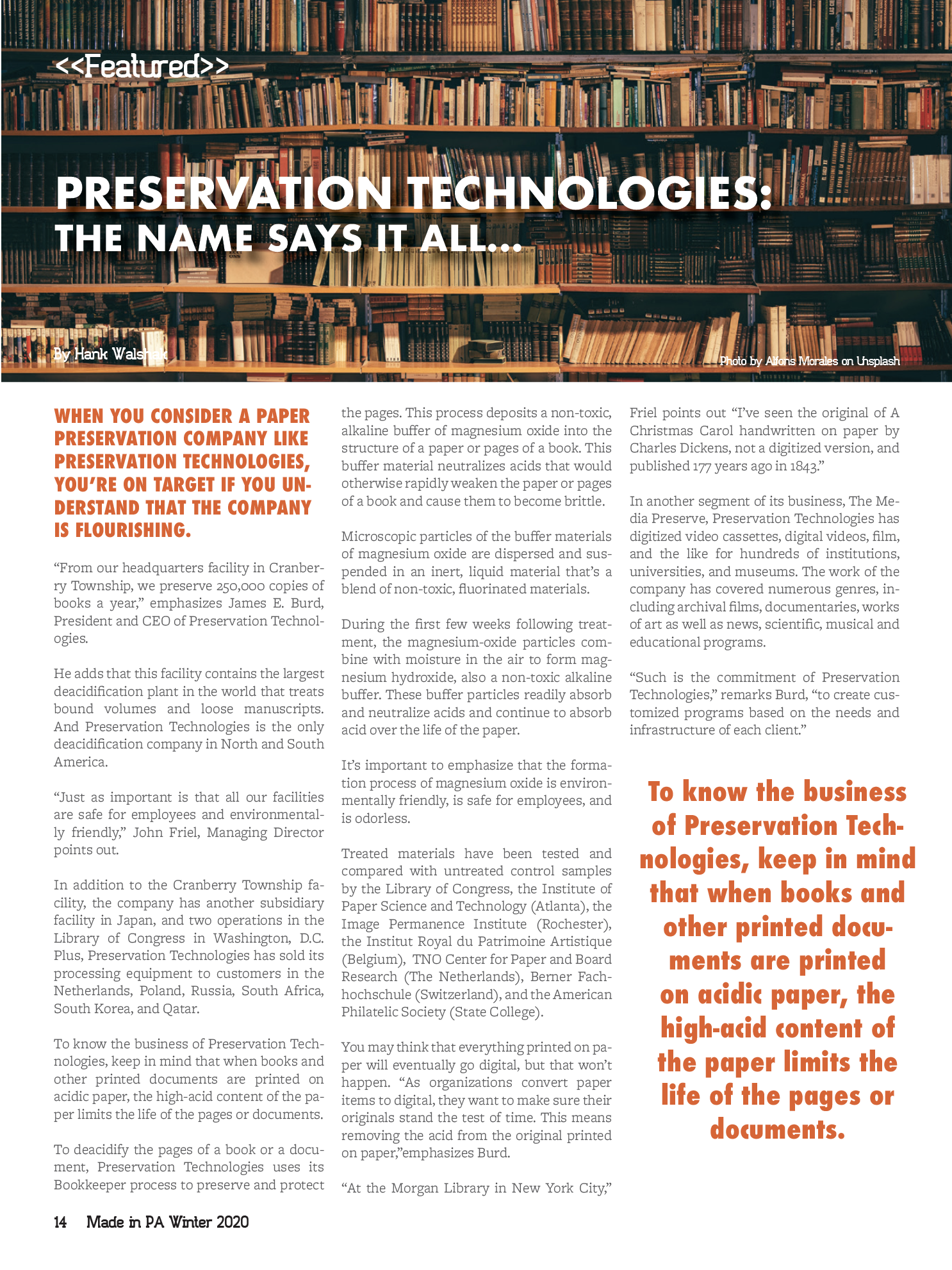Preservation Technologies: The Name Says it All
Hank Walshak
WHEN YOU CONSIDER A PAPER PRESERVATION COMPANY LIKE PRESERVATION TECHNOLOGIES, YOU'RE ON TARGET IF YOU UNDERSTAND THAT THE COMPANY IS FLOURISHING.
“From our headquarters facility in Cranberry Township, we preserve 250,000 copies of books a year,” emphasizes James E. Burd, President and CEO of Preservation Technologies.
He adds that this facility contains the largest deacidification plant in the world that treats bound volumes and loose manuscripts. And Preservation Technologies is the only deacidification company in North and South America.
“Just as important is that all our facilities are safe for employees and environmentally friendly,” John Friel, Managing Director points out.
 In addition to the Cranberry Township facility, the company has another subsidiary facility in Japan, and two operations in the Library of Congress in Washington, D.C. Plus, Preservation Technologies has sold its processing equipment to customers in the Netherlands, Poland, Russia, South Africa, South Korea, and Qatar.
In addition to the Cranberry Township facility, the company has another subsidiary facility in Japan, and two operations in the Library of Congress in Washington, D.C. Plus, Preservation Technologies has sold its processing equipment to customers in the Netherlands, Poland, Russia, South Africa, South Korea, and Qatar.
To know the business of Preservation Technologies, keep in mind that when books and other printed documents are printed on acidic paper, the high-acid content of the paper limits the life of the pages or documents.
To deacidify the pages of a book or a document, Preservation Technologies uses its Bookkeeper process to preserve and protect the pages. This process deposits a non-toxic, alkaline buff er of magnesium oxide into the structure of a paper or pages of a book. This buff er material neutralizes acids that would otherwise rapidly weaken the paper or pages of a book and cause them to become brittle.
Microscopic particles of the buff er materials of magnesium oxide are dispersed and suspended in an inert, liquid material that’s a blend of non-toxic, fluorinated materials.
During the first few weeks following treatment, the magnesium-oxide particles combine with moisture in the air to form magnesium hydroxide, also a non-toxic alkaline buff er. These buff er particles readily absorb and neutralize acids and continue to absorb acid over the life of the paper.
It’s important to emphasize that the formation process of magnesium oxide is environ-mentally friendly, is safe for employees, and is odorless.
Treated materials have been tested and compared with untreated control samples by the Library of Congress, the Institute of Paper Science and Technology (Atlanta), the Image Permanence Institute (Rochester), the Institut Royal du Patrimoine Artistique (Belgium), TNO Center for Paper and Board Research (The Netherlands), Berner Fachhochschule (Switzerland), and the American Philatelic Society (State College).
You may think that everything printed on paper will eventually go digital, but that won’t happen. “As organizations convert paper items to digital, they want to make sure their originals stand the test of time. This means removing the acid from the original printed on paper,”emphasizes Burd.
“At the Morgan Library in New York City,” Friel points out “I’ve seen the original of A Christmas Carol handwritten on paper by Charles Dickens, not a digitized version, and published 177 years ago in 1843.”
In another segment of its business, The Media Preserve, Preservation Technologies has digitized video cassettes, digital videos, film, and the like for hundreds of institutions, universities, and museums. The work of the company has covered numerous genres, in-cluding archival films, documentaries, works of art as well as news, scientific, musical and educational programs.
“Such is the commitment of Preservation Technologies,” remarks Burd, “to create customized programs based on the needs and infrastructure of each client.”